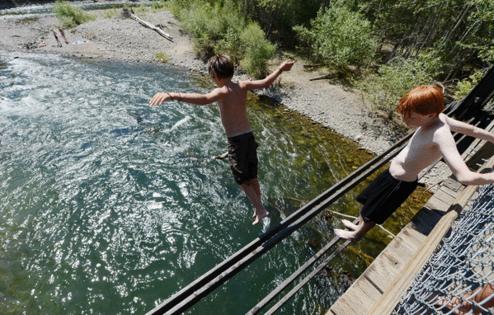Idaho drought conditions worsen fire risk, water shortage
Published in Weather News
BOISE, Idaho — Nearly record-low rain in the spring combined with extreme heat could put a strain on agriculture and worsen fire risk throughout Idaho, weather officials have warned.
Most of the state is under drought after a particularly dry spring, according to the U.S. Drought Monitor, prompting water shortages, while the Boise area’s dry conditions pose wildfire risks.
Snake River reservoirs, which are essential to irrigating Idaho crops like wheat, potatoes and sugar beets, are already facing abnormally low water levels that are likely to get worse, said David Hoekema, a hydrologist at the Idaho Department of Water Resources.
“We’re seeing (water) storage use much faster than normal and ahead of schedule,” Hoekema told The Idaho Statesman.
Statewide, this spring was the fifth-driest on record and second-driest since 1931, beaten only by spring 2021, according to the National Oceanic and Atmospheric Administration. NOAA forecasts “above normal” temperatures for the rest of the summer.
Without rain, farms with irrigation systems must tap into stored water for their crops, Hoekema said, which has rapidly depleted reservoirs around the Snake River.
The water outlook for Boise and most of Southwest Idaho is better. Hoekema said the reservoirs the Treasure Valley uses – Anderson Ranch, Arrowrock and Lucky Peak – remain at normal levels for the season after plenty of rain last year and adequate snowpack from the winter.
But the Boise area is still “abnormally dry,” according to the U.S. Drought Monitor. Hoekema said that’s an indication that drought conditions could develop.
For Boise, the main concern is the fire risk. National Weather Service meteorologist Jay Breidenbach told the Statesman that the dryness this summer could “set the stage” for widespread blazes.
National Interagency Fire Center meteorologists told the Statesman in June that this year’s fire season could be worse than 2024, which cost Idaho $60 million and set hundreds of thousands of acres ablaze.
The state has set less money aside to fight fires this year, which Gov. Brad Little said in an April statement may be insufficient.
“Simply put, if we have a bad fire year, the amount the Legislature appropriated for fire suppression will not be enough to cover the bills for the fires the state is responsible for,” he said at the time while approving the budget.
Many farms in Southern Idaho are non-irrigated and rely on rainfall, a practice known as dryland farming, Idaho wheat commissioner Wayne Hurst told the Statesman.
Hurst said that for dryland farmers, the dry spring has already affected their livelihoods.
“The last several months have been really tough for them and their crops because they never received the natural precipitation they rely on,” Hurst said. “There may be water in the reservoirs, but they have no access to that.”
Hurst explained that crops like wheat rely on spring rainfall or irrigation for a successful harvest. The effect on dryland farmers has been “severe,” he said, while irrigated farms are still faring fine for now.
If heavy reservoir reliance continues in Southern Idaho, farmers who irrigate may soon run into water shortages, Hoekema said.
The Department of Water Resources released a report on July 10 that predicted a shortfall of 75,300 acre-feet of water for the Twin Falls Canal Co., which manages water resources in part of the Magic Valley region. One acre-foot is about the volume of a football field dug one foot deep, according to the U.S. Geological Survey. The report noted that other water districts in the region are, so far, not facing shortfalls.
In Idaho, water rights are determined by seniority, the July 10 report explained. Older farms have rights to more water. Hoekema said that many farmers need to stop irrigating their crops when there are shortages, or make economic choices about which crops to water.
Hurst, as a farmer of more than 40 years, has firsthand experience with making these decisions. He grows wheat, sugar beets, alfalfa and beans on a farm near Declo that his family has cultivated for three generations.
“There have been times when we haven’t been able to water sugar beets, for example, in late summer, early fall, because the water hasn’t been there,” Hurst said.
Breidenbach told the Statesman that conditions are forecasted to remain relatively hot and dry for the rest of the summer.
“When it’s hot, crops use more water,” Breidenbach said. “So hot and dry is about the worst you can imagine right now.”
A weather pattern called the North American Monsoon, which mainly affects southwestern states, is kicking into gear, Breidenbach said. According to NOAA, the monsoon can bring thunderstorms and rainfall to the typically dry region during summer months.
“Very occasionally, very rarely, we’ll get monsoon moisture up into southern Idaho,” Breidenbach said. “But it’s something that I wouldn’t say we could count on just yet.”
Hoekema said the Idaho Water Resource Board has been developing strategies to lessen the effect of droughts, such as recharging aquifers with excess water in the winter and spring.
Hydrologists’ understanding of Idaho water resources are also getting better, Hoekema noted. Although they have historically looked at snowpack as the main telltale of summer water supply, they are realizing that summer temperatures and spring precipitation are better indicators.
©2025 The Idaho Statesman. Visit idahostatesman.com. Distributed by Tribune Content Agency, LLC.







Comments